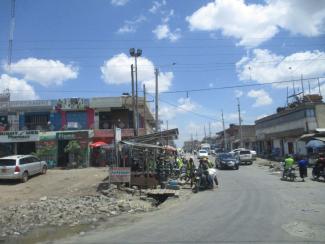Non-motorised transport
Expand sidewalks and bike lanes
 dem
dem
As a means of getting from one place to another, walking or cycling have a number of advantages: they are eco-friendly and inexpensive, have health benefits and require very little space. They do not lead to the negative consequences of motorised transport such as air pollution, noise exposure and greenhouse gas emissions, which contribute to global warming.
Nonetheless, car traffic is prioritised in many places. The car is a status symbol that stands for prosperity and progress. It also has great economic relevance. Without motorised transport, trade in its present form would be impossible, remote areas would be nearly inaccessible and nation-wide distribution networks would seem utopian. On the other hand, systemic limits have been reached in many congested areas and metropolises. In those places, more non-motorised transport can significantly contribute to solving problems. A good example is Bangkok, which is famous for its permanent traffic jams (see box).
Many fatalities
Pedestrians and cyclists are killed disproportionately often in traffic accidents (see article by Katja Dombrowski in D+C/E+Z e-Paper 2020/01, Focus section). That is true worldwide, but the risk to non-motorised road users is highest in Africa’s big cities. For example, pedestrians made up 65 % of all traffic fatalities in the Kenyan capital of Nairobi in 2016, according to official data. Like other metropolises around the world, Nairobi’s urban planning has badly neglected cyclists, pedestrians and other non-motorised road users for decades. It focused instead on expanding infrastructure for motor vehicles, particularly cars.
In 2015, however, Nairobi began to change course. In cooperation with the Share the Road Programme of the UN Environment Programme (UNEP), which aims to improve the situation of pedestrians and cyclists in the global South, the city drafted a policy specifically for non-motorised transport. Nairobi’s governor at the time, Evans Kidero, gave several reasons, including the following: “There is clear evidence that non-motorised transport provides efficient mobility with substantially low investment.”
First and foremost, such a policy must improve conditions for strongly disadvantaged road users, namely pedestrians and cyclists. Relevant measures include building sidewalks and bike trails as well as calming down traffic, for instance, by introducing 20 mile per hour zones or curves in the road. Such measures should be supplemented by awareness-raising campaigns. In order to show that they are serious, Nairobi’s municipal leaders determined that 20 % of the road-construction budget must be used for infrastructure for non-motorised and public transport.
Carly Koinange, the director of the Share the Road Programme, thinks Nairobi is setting a good example not only for Africa. The earmarking of funds is something the global North could adopt too, she told Zeit online, the web version of a prominent German newspaper. Her intention is not to create a rivalry between developing and industrialised countries, but rather to promote equity among all the different road users.
Only time will tell how successful and sustainable Nairobi’s new traffic policy is. Between 2013 and 2019, the number of the city’s registered motorised vehicles climbed from just under 2 million to about 3 million. Traffic jams and chaos are part of everyday life – and they go along with serious economic costs: according to World Bank estimates, Nairobi loses half a million dollars a day due to traffic jams.
Transport planners in Nairobi are promoting non-motorised transport to improve living for all residents in terms of better air quality and less noise. Furthermore, according to Kidero, private households will be able to save money because non-motorised transport tends to be cheaper. The construction of sidewalks and bike paths will improve access. And since the majority of lower-income people depend on non-motorised transport, their income situation will improve and they may even find opportunities to earn additional income.
Better infrastructure for non-motorised traffic does not only serve environmental goals, but social justice as well. One reason is that the world’s poor suffer from the environmental damage caused by car traffic in particular. The study “Weniger Autos, mehr globale Gerechtigkeit” (“Fewer cars, more global justice”), which was published by the non-governmental agencies Misereor, Brot für die Welt and PowerShift, concludes that “the internal combustion engine must be swiftly renounced in the interest of environmental and climate justice.” And the authors of Share the Road Programme’s 2018 annual report went so far as to state: “Sidewalks are the only legitimate, democratic place where every citizen is truly equal.”
Attitudes must change in both urban and rural areas in order to keep the climate crisis in check. The World Meteorological Organization (WMO) recently announced new record levels of greenhouse gas emissions: instead of plateauing or declining, emissions continue to rise. Eighty percent of the greenhouse effect can be attributed to carbon, and just under 18 % of carbon emissions result from transportation.
Nicholas Hollmann is an urban planning expert and specialises in transport. He taught at the International College at King Mongkut’s Institute of Technology in Bangkok from 2010 to 2014.
nicholas.hollmann@gmx.net
Links
Contribution of modes of transport to CO2 emissions worldwide:
https://de.statista.com/statistik/daten/studie/317683/umfrage/verkehrsttraeger-anteil-co2-emissionen-fossile-brennstoffe/
Share the Road Programme, Annual Report 2018: Investing in people who walk and cycle.
https://wedocs.unep.org/bitstream/handle/20.500.11822/27503/SRP2018.pdf?sequence=1&isAllowed=y
Misereor, Brot für die Welt, PowerShift (eds.), 2019: Weniger Autos, mehr globale Gerechtigkeit (Fewer cars, more global justice, in German only).
https://www.misereor.de/fileadmin/publikationen/Studie-Weniger-Autos-mehr-globale-Gerechtigkeit.pdf
A reader's response (26 February 2020)
I have been living in Nairobi for four years. I move around in the city a lot, but even though I would like to go by foot or ride a bicycle, I always use the car. Since I first came here, nothing serious has happened in terms of expanding sidewalks or bike lanes. The city still has only one bike lane, stretching two kilometers along UN Avenue. It is hardly useable, however. Sidewalks only exist in properous neighbourhoods.
I find it questionable to publish an essay that does not tackle day-to-day reality, but only relates plans and projections. It should be clear that having a plan is something completely different from implementing it. Given that D+C/E+Z has readers, I expect the next group of visiting members of Germany’s Bundestag to ask me to show them the positive examples of traffic planning in Nairobi. That will result in disappointment and the question why Germany is supporting development cooperation at all. Embellishing things only helps in the short term – if at all.
Dr. Jan Cernicky, Konrad-Adenauer-Foundation, Nairobi

